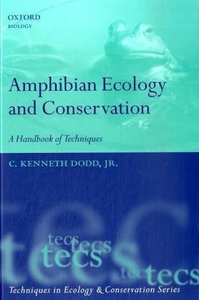Models in field studies of temperature and moisture
Rowley, Jodi J.L., and Alford, Ross A. (2010) Models in field studies of temperature and moisture. In: Dodd, Jr, C. Kenneth, (ed.) Amphibian Ecology and Conservation: A Handbook of Techniques. Oxford University Press, New York, USA, pp. 387-406.
|
PDF (Published Version)
Restricted to Repository staff only |
||
![[img]](https://researchonline.jcu.edu.au/10607/2.hassmallThumbnailVersion/10607_Rowley_%26_Alford_2010_Book_Cover.jpg)
|
Image (JPEG) (Book Cover)
Download (20kB) |
Abstract
In ectothermic organisms, variation in body temperature directly affects factors such as rates of energy acquisition, growth, and reproduction (Shoemaker and McClanahan 1975; McClanahan 1978). Temperature also exerts a strong infl uence on ecological interactions such as predator–prey and host–pathogen interactions, and changes in temperature can completely reverse the outcome of such interactions at both the individual and population levels (Elliot et al. 2002; Woodhams et al. 2003). Although the body temperature of terrestrial ectotherms is broadly correlated with environmental temperature, the actual body temperatures of many species can differ considerably from macroenvironmental temperatures due to species-specifi c behavior, physiology, morphology, and microenvironment use. As a result, ectotherms exposed to identical macroenvironmental conditions can experience very different body temperatures (Kennedy 1997).
The physiology and ecology of amphibians, and their thermal relations, are also strongly influenced by moisture. The degree of evaporative water loss (EWL) varies considerably within and among species (Shoemaker and Nagy 1977; Wygoda 1984; Buttemer et al. 1996; Young et al. 2005), and individuals of many species are able to adjust their rates of water loss over relatively short periods of time (Withers et al. 1982; Wygoda 1989a; Withers 1995; Tracy et al. 2008). The moisture and thermal environments, and interactions between them, can constrain the performance of amphibians (Snyder and Hammerson 1993; Tracy et al. 1993). However, the actual temperature and humidity experienced by an amphibian can differ dramatically within a range of available macroenvironmental conditions, depending on microenvironment use (Schwarzkopf and Alford 1996; Seebacher and Alford 2002; Rowley and Alford 2007a). To understand how the environment is experienced by amphibians in the field, both the thermal and moisture environments must be characterized as they are experienced by amphibians.
Understanding the thermal and water relations of amphibians in the field is important not only for understanding their biology, but also for conservation. Recent declines in amphibian populations around the world have been attributed in part to the epidemic disease amphibian chytridiomycosis (Lips et al. 2006). Changes in thermoregulatory opportunities available to rainforest frogs may have contributed to their widespread declines in association with the disease (Pounds et al. 2006). Laboratory experiments have shown that elevated body temperatures, as can be produced by basking, can cure amphibians of the disease (Woodhams et al. 2003). Global warming is also likely to have a large impact on many species, with macroenvironmental modeling suggesting that the distributions of many ectothermic species will be dramatically altered (Thomas et al. 2004). This approach is limited by the fact that the present distributions of many species may not refl ect their fundamental climatic requirements (Parmesan et al. 2005). Understanding those requirements may aid in refi ning such predictions (Kennedy 1997; Parmesan et al. 2005).
| Item ID: | 10607 |
|---|---|
| Item Type: | Book Chapter (Research - B1) |
| ISBN: | 978-0-19-954119-5 |
| Keywords: | tropical biology, techniques, amphibian ecology, physiology, decline, behaviour |
| Date Deposited: | 30 Apr 2010 01:53 |
| FoR Codes: | 05 ENVIRONMENTAL SCIENCES > 0502 Environmental Science and Management > 050202 Conservation and Biodiversity @ 100% |
| SEO Codes: | 96 ENVIRONMENT > 9608 Flora, Fauna and Biodiversity > 960805 Flora, Fauna and Biodiversity at Regional or Larger Scales @ 100% |
| Downloads: |
Total: 362 Last 12 Months: 5 |
| More Statistics |



